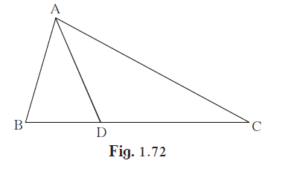In ∆ABC, B - D - C and BD = 7, BC = 20 then Find following ratio. \[\frac{A\left( ∆ ABD \right)}{A\left( ∆ ABC \right)}\]
Problem Set 1 | Q 2.2 | Page 27
In ∆ABC, B – D – C and BD = 7, BC = 20 then Find following ratio.
\[\frac{A\left( ∆ ABD \right)}{A\left( ∆ ABC \right)}\]

\[\frac{A\left( ∆ ABD \right)}{A\left( ∆ ABC \right)} = \frac{\frac{1}{2} \times AX \times BD}{\frac{1}{2} \times AX \times BC}\]
\[ = \frac{BD}{BC}\]
\[ = \frac{7}{20}\]
Answer:-
Step 1: Use the formula for the area of a triangle
This step involves applying the formula for the area of a triangle to find the ratio of the areas of ∆ABD and ∆ABC. The formula states that the area of a triangle is equal to half the product of its base and height. We can write this as:
A(∆ABD) = (1/2 * AX * BD) A(∆ABC) = (1/2 * AX * BC)
Step 2: Substitute the expressions for the areas
This step substitutes the expressions for the areas of the triangles from Step 1 into the expression for the ratio of the areas. This gives us:
A(∆ABD)/A(∆ABC) = [(1/2 * AX * BD)/(1/2 * AX * BC)]
Step 3: Simplify the expression
This step simplifies the expression obtained in Step 2 by cancelling the common factor of (1/2 * AX) from both the numerator and denominator. This gives us:
A(∆ABD)/A(∆ABC) = BD/BC
Step 4: Substitute the given values
This step substitutes the given values for BD and BC into the expression obtained in Step 3, which gives us the ratio of the areas of the triangles ∆ABD and ∆ABC as:
A(∆ABD)/A(∆ABC) = 7/20
Therefore, the code represents a step-by-step solution to finding the ratio of the areas of two triangles given the lengths of their bases and one of their heights. The solution involves applying the formula for the area of a triangle and simplifying the resulting expression.
Problem Set 1 | Q 2.2 | Page 27
Click Here for All Textbook Soutions of Chapter 1: Similarity
